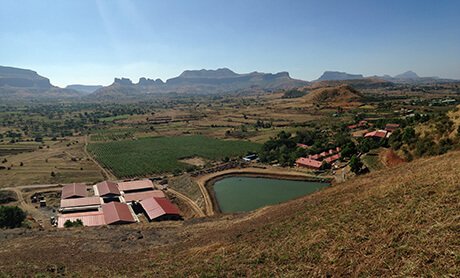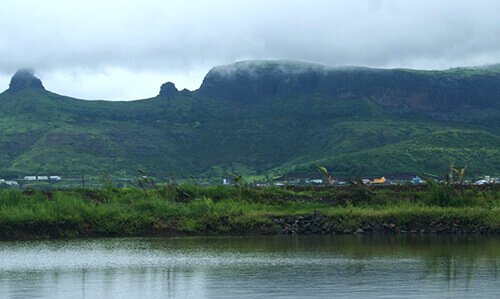Out of the six shuddhikriyas, the shuddikriya for the cleaning of the nasal path is known as neti. The aim of the process is to purify the breathing path right from the nostrils to the throat. If the aim is achieved using water, the process is known as Jalneti. If the aim is achieved by using a thread of cloth ( sutra ), then it is known as Sutraneti. If with the help of modern science, a catheter is used instead of sutra, then it is known as Dandneti. In short, neti is the process of cleaning the nasal path. In this syllabus, we will see how it is done with the help of the water. That means we will study only Jalneti.
Traditionally, the process is performed by dipping the face into the river water, inhaling the water through the nostrils and letting it out through the mouth. The reverse process is sucking the water in by mouth and exhaling it through nostrils.
If it is not possible to visit the river everytime, then the process maybe performed by taking the water into the folded palms and inhaling it through nostrils or sucking it by mouth.
If the process is to be performed in this manner, there are too many difficulties. If the water is to be inhaled through nose, sneezes occur and the water is let out through the nose only. Or if the water cannot be thrown out by way of mouth, it gets stuck and can cause trouble. The water can deposit itself into the sinus and can cause headaches. Hence, there is another method which can be practiced by all without such difficulties and it is easier and useful to practice it.
In this method, a feeding cup of china with a pout is used. Earlier, there were pots with the pouts, they can also be used. In fact, a utensil which can easily pour water into the nostril can be used. A utensil with stainless steel or brass is prepared specially for the process, which has double barrel pout with a little broad tip.
Put warm water into the utensil and add a little salt in it. Tilt the neck and touch the tip of spout to one of the nostrils. Open the mouth and continue breathing through it. Gradually pour water into the nostril. Since the breathing is continued through the mouth, the water straightway goes through the food pipe into the throat to the stomach. Just as we drink water through the mouth, in the same way it can be drunk through the nose. When some water is drunk though one nostril, perform the process with the other one. This is process is not neti, but when one is accustomed to drinking water through nose, then practicing neti is easier.
Instead of swallowing water drunk through the nose, tilt the neck further and take it out through the other nostril. It is essential to find the pose of the neck here. When the pose is found, the rest of the process is easier. The water poured through one nostril can easily come out of the other. The breathing is naturally through the mouth at this time. Pour water into the left nostril and take it out of the right, then drink it by the right one and take it out of the left.
Then stand bent at the waist, put the hands onto the waist, move them in half rotation and perform a process similar to Kapalbhati.
The duration or the reiterations of the process cannot be stated. But the amount of water to be used can be stated. For one nostril, generally half a liter of water is to be used. The water should be used at a stretch or with some rests. Since this is a shuddhikriya, one should not include it in daily lifestyle. Whenever, the nasal path needs cleaning, the process can be used. However, till the process is learnt thoroughly, it may be practiced daily. Once learnt, it should be used as per the need.
The process achieves cleaning of the nasal path with the help of the water, but this is not the only aim behind the process. The texts state that the process eliminates kaphadosha and diseases occurring in the old age.
If the process is studied by differentiating the temperature of the water used and also the amount of the salt used, the skin in the nasal path gets used to the osmotic pressure. Also, the organs get used to the different temperatures and can continue working without any disturbance. The nasal path does not suffer from any changes in the season, hence can get freed from the long duration cold or sinus troubles. If the water is heated a little bit more and contains extra salt, then it can also absorb the water from the swollen parts of the nasal path or the fluid in the sinus and these parts can get purified.
Apart from the purification of the nasal path, the other attached sensory perceptive organs such as eyes, ears can also be affected in a good manner and their efficiency is increased.
If the mouth of the Eustachian tube in the throat is swollen and clogged, it also gets opened up. It is also experienced that the study proves useful in case of many diseases of the nasal tract.
For the practice of pranayam, both the nostrils should be open, that can be achieved through this process.
None of the texts mention the above described process as Jalneti. However, Gherandsamhita, describes three types of Kapalbhati, the first being Vatkram Kapalbhati, which is same as Kapalbhati that we have seen earlier. The second and the third is Vyutkram and Sheetkram Kapalbhati. That is the Jalneti that we have learnt. The first chapter describes :
Meaning -
The process of inhaling water through both the nostrils and throwing it out by way of mouth repeatedly is known as Vyutkrama Kapalbhati, which eliminates shleshma doshas.
Meaning -
Inhaling water through the mouth and exhaling through both the nostrils, the study of this makes the body glow as that of Kamdeva.
Meaning -
Due tot he study of Sheetkrama Kapalbhati, the diseases of the old age do not arise, there are no fevers, the body is controlled completely and the kapha doshas are eliminated.
When the meaning of the shlokas are understood completely, it is released that they describe complete stage. If an attempt is made to achieve complete stage, it will be difficult. So we have described the process starting from easier to difficult and then the complete stage. If it is studied in that manner, it will not be troublesome.
Phone - +91-9822770727
E-mail - yoga@yogapoint.com or yogapoint108@gmail.com

Yoga Vidya Dham, Kaivalya Nagari,
College Road, Nashik - 422005.
Maharashtra, India.
Phone - +91-9822770727 (for courses in ENGLISH)
+91-253-2318090 (For courses, in HINDI or MARATHI)
(Please call during 9.00 AM to 5 PM Indian Time)
E-mail - yoga@yogapoint.co or yogapoint108@gmail.com
Village Talwade, Trimbak, Nasik
Maharashtra,India.
Phone - +91-9822770727
E-mail - yoga@yogapoint.com or yogapoint108@gmail.com
